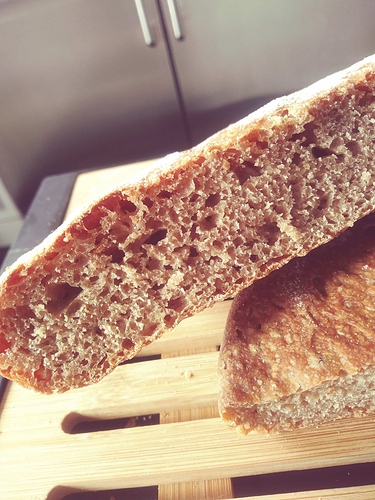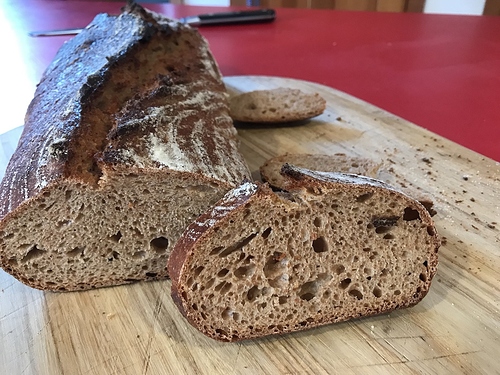I am posting my failures on 2 bakes I have had using a technique off Breadwerx. I also included the URL for anyone that has not seen. I think my issue is actually the protein content of the Turkey Red in attempting this but I am no expert BY NO MEANS. Each direction is followed by what I did in strong text.
My bake diary:
Breadwerx Boule http://www.breadwerx.com/how-to-get-open-crumb-from-stiff-dough-video/#comment-2119
(First Bake)
460g whole wheat flour
Used Turkey Red Heritage whole wheat, unsifted
290g water
10g salt
55g starter
Directions:
Mix flour water and salt, refrigerate until bedtime then remove and let sit on counter to warm.
Dough was on the wet side but manageable. It was elastic and had structure to it
In morning add starter and dimple in, rolling in as necessary per video. Typically 3 rounds of folds until dough tightens up.
Dough turned very sticky almost gooy and lost all the structure. It was extremely extensible.
Bulk ferment for about 6 hours. Every 2 hours do a stretch and fold (S&F) total of 3
Each successive S&F made the dough worse. Dough did not rise but spread out. Thinking there must have been something wrong with the starter I tried to save by adding ½ teaspoon of instant yeast and folded in. Dough became very active and puffed up.
Pre-round into boule.
Dough degassed completely, sticky, very messy, dipping hand in water made it worse
Shape boule for baking.
Bake at 450F
Results:
Boule flattened out to a 1 1/2” pancake. Crumb very dry, more like a quick bread. Made bread crumbs out of it.
Observations/Questions: Was starter bad or was the proteins in the flour degraded by the long autolyse?
Breadwerx Boule
(Second Bake)
436g Turkey Red flour: sifted through a 40 and 50 mesh screen. Added 19g of Vital Wheat Gluten
24g whole wheat flour
290g water
10g salt
19g VWG
55g starter
Preparation: Made a new starter from 10g of the old over a 2 day period. Starter doubled in size so refrigerated overnight.
Directions:
Mix flour water and salt, refrigerate until bedtime then remove and let sit on counter to warm.
Did not refrigerate, mixed in the morning and let sit out for 2 hours on the counter. Checked at 1 hour to check for structure.
In morning add starter and dimple in, rolling in as necessary per video. Typically 3 rounds of folds until dough tightens up.
Dough very tight after first fold and wanted to tear. Let sit 15 minutes and did another fold. Dough was not smooth like in the video and was very tight (looked a bit rough on the outside) It would not extend out very easy. (too much gluten development?)
Bulk ferment for about 6 hours. Every 2 hours do a stretch and fold (S&F) total of 3
Bake room was 78F so I expected dough to rise fairly quickly. After 3 hours and 2 S&F’s there was no significant rise to the dough. Dough though was holding its shape pretty well without spreading.
Pre-round into boule.
Preshaped tight.
Shape in tight boule and place in banneton. Let sit for 2 to 4 hours.
Dough spread to edge of banneton and top in 2 hours. Then stopped. When placed in combo cooker it felt very soft and even with a light hand seemed to degass very easily.
Bake at 450F
Results:
Boule flattened out to a 1 1/2” pancake (slightly less than the height of the banneton.) Crumb moist with medium holes and a few ¼” holes throughout. Crumb nice texture, good flavor, poor rise. Crust a little not much.
Observations/Questions: Enzyme degradation should not be a problem with this bake as only a 2 hour autolyse and only until the dough had structure. Starter not the problem as was very active when added to mix. Protein content of flour? Supposedly this wheat makes an excellent bread flour and have used previously by itself and to make my rye each week. Was not old flour as I grind fresh for each bake. If there was an issue with gluten the added VWG at 1 teaspoon per cup of flour should have helped and seemed to as was a very tight loaf (until baking.)
The combo cooker was heated WITH THE DOUGH IN IT to try and avoid degassing the dough when it was proofed and placed.






